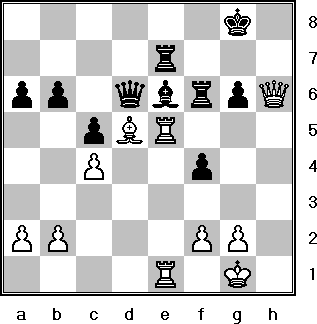|
Lesson
#5
Third Attitude of a Chess Master
Today I have the pleasure of sharing with you the third attitude of the chess
master. In past issues we discussed the first two attitudes: patience and
self-study. With patience you can learn to avoid big mistakes. With self-study
you can learn from your own games. Chess masters also have one other
all-important attitude.
Embracing the Truth
The master seeks to find something that is true in a chess game. Once he
finds it, this truth will guide his decisions on what to do. The truth is his
most important advantage in the game. It is often not easy to find. And it
is often not easy to embrace---to pursue so completely that you win the game
because of it.
Lets look at an example played by the great Capablanca (White) against Blanco
(Black).
|
|
 |
White to move
|
The material is even and the pawns structure is also pretty even. But
Capablanca has one advantage. What is it? Study the position above and search
for whiteís advantage.
Yes! Its the pin! Blackís bishop on e6 is in a very bad pin. Capablanca
understood the truth in this position: "the pin will win". But how
does he embrace this truth? He makes every effort for the rest of the game to
take advantage of this pin. He keeps adding pressure until blackís position
falls apart.
Watch how the great master proceeds. With 1. Bd5 he adds pressure and
after 1. ... Qd6 2. Qe3 Re7 all of blackís pieces, including his
king have to guard the poor bishop on e6.
Unfortunately, Capablanca canít add another attacker. Exchanging all the
pieces isnít good enough. It just leads to a drawn endgame. Well it looks like
heís stuck. How can he make progress? Did you notice how all of blackís
pieces are disorganized and tied up guarding his helpless bishop? They are too
busy defending to do a good job of defending elsewhere. Watch how Capablanca
creates another weakness while maintaining the pin.
3. Qh6! by attacking the h-pawn Capablanca is starting to overload blackís
pieces and forces 3. ... Kg8. (3. ... Ke8 drops a pawn due to the
pretty 4. Qh4 attacking the rook on f6.) Capablanca adds more pressure with 4.
h4.
|
|
 |
White to move
|
Can you find whatís wrong with 4. ... Kh8 now? The black king has gone
too far away from the pinned bishop and 5. Qe3 would pick it off. So with
nothing useful to do black passed with 4. ... a6.
Capablanca pried open the position with 5. h5 f4 6. hxg6 hxg6. This
brings us to the key position that Capablanca has played for (shown on the
right).
Did you remember the truth that Capablanca had embraced? He knew that
"the pin would win". Now he proved it with the beautiful 7. Rxe6!
and black resigned.
But why did black resign? After 7. ... Rexe6 8. Rxe6 Rxe6 9. Qxg6+ Kf8 10.
Qxe6 white wins a piece. The pin did win. (try saying that ten times real fast!)
You will find the truth and beauty hang out together. By pursuing a truthful
cause like Capablanca, you will often be able to discover beautiful combinations
that fulfill the truth you seek.
To develop your ability to discover and embrace the truth in chess I
recommend going over the games of Morphy, Capablanca and Fischer. They had a
special clarity and unity of purpose in their games. When you play over the
games try to find the truth that they knew. Notice how they pursued it. And
notice how it often ended with a beautiful combination.
If you find benefit from this chess attitude you might consider using it in
your life beyond the 64 squares.
Home Page ∑
More Lessons
(c) 2001 Ross Stoutenborough
|